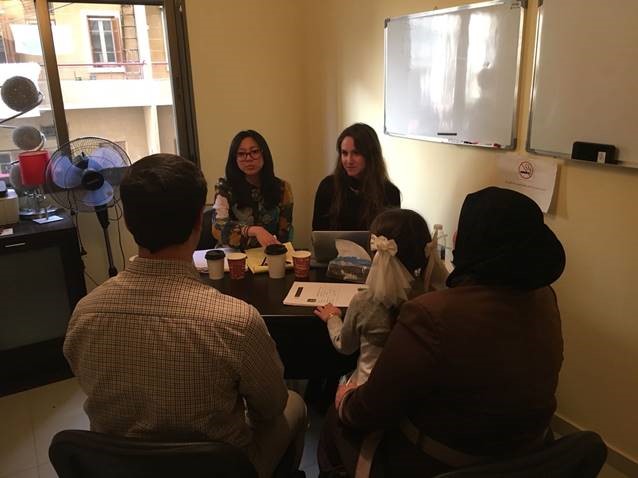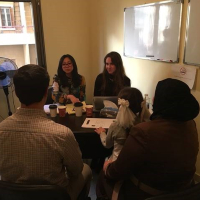USC International Human Rights Clinic student-attorneys help Syrian refugees escape persecution
By Diane Krieger
After four years in limbo Abdulbaset Nasri. his wife Janan and their four children are safe in Italy.
The good news caught their lawyer, Natalia DaSilva, completely off guard.
“I was so excited. I was with colleagues and I just had to tell everybody,” says DaSilva, now a staff attorney with Legal Services of Northern California.
Eighteen months had passed since DaSilva worked on the Syrian family’s refugee resettlement claim. Back then she was a second-year law student with USC Gould’s International Human Rights Clinic on a spring break legal-aid mission to Lebanon.
By the time the email from the clinic’s director, Prof. Hannah Garry, announced the outcome in late 2019, DaSilva had already graduated and taken the California bar.
The passage of time, however, had not diminished her affection for the Nasris.
“I still reread that email and tear up a little bit. It means a lot to me,” says DaSilva, who earned both of her degrees at USC — her bachelor’s degree in 2016 and JD in 2019 — and now lives in Sacramento.
DaSilva and her classmate Bettina Tiangco JD 2019, a Stanford graduate originally from San Diego, had worked around-the-clock on the Nasri family’s case through a nine-day field experience that puts USC Gould students at the epicenter of the world’s worst humanitarian crises. Now in its third year, the travel program is funded by alumnus Barry McCabe JD 1977.
At the Beirut headquarters of the International Refugee Assistance Project — known as IRAP — the students hit the ground running in March 2018. On day one, DaSilva and Tiangco met with their clients to assess if they had a legal pathway to resettlement through the Office of the United Nations High Commissioner for Refugees (UNHCR).
“At that point the case file was quite thin,” says Garry, who organized the trip and supervised the students.
 |
| International Human Rights Clinic students conducting an intake interview with Syrian refugees. |
DaSilva and Tiangco spent long days in separate interviews with the Nasris, building out their dossier.
Abdulbaset Nasri, a carpenter from Aleppo, had been arrested, beaten and tortured repeatedly in Syria —often held for days or weeks. He had sheltered his wifefrom the ugliest details, but there was no holding back for the official refugee filing.
“They were opening up, trusting us with their stories, and we had no guarantees to offer that it would lead to anything fruitful,” says Tiangco, now an associate in the corporate department of Ropes & Gray LLP’s San Francisco office. “There were times when I felt very emotional, but I had to stay professional and honor their strength and grace.”
During breaks DaSilva, who speaks some Arabic, played alphabet games with the youngest child in another room. Aged 7 to 15 years old, the Nasri children were traumatized after witnessing horrific violence, including bombings and beheadings. One child had stopped speaking and later was diagnosed with epilepsy.
After a difficult journey from Syria to Lebanon over rough, mountainous terrain, they found they still weren’t safe in Beirut. Abdulbaset Nasri says Hezbollah, the Shiite Islamist political party and militant group that controls large parts of South Beirut and Southern Lebanon, routinely followed and accosted him and made death threats against the family. His health was precarious after suffering food deprivation while in detention and sustaining nerve damage to his spine from severe beatings. He developed a heart condition requiring surgery.
Late into the night, the Gould students transcribed their interviews, meticulously prepared the family’s intake report and drafted their declarations. By the end of the trip, they had completed and filed the resettlement submission.
Months later, they recall, their initial petition was “deprioritized”— in effect, shelved — by UNHCR. But IRAP resubmitted the case to Humanitarian Corridors, an Italian humanitarian visa program. That second submission was approved in late 2019.
USC Gould students Ashley De Vance JD 2019 and Matt Saria JD 2019 handled another Syrian refugee family’s claim on the 2018 trip.
Fatima Yusif had fled Daraa, Syria, in 2015 with her three young children. Her husband, Salam, a hairdresser, had left two years earlier to avoid conscription in President Bashar al-Assad’s army. When the family reunited in Beirut, all three children were malnourished. One could hardly walk due to rickets; another was at risk of going blind, having undergone unsuccessful eye surgery in Syria.
Their story also has a happy ending. After receiving a low priority designation from the UNHCR, the Yusifs’ case, too, was resubmitted by IRAP and approved by Humanitarian Corridors. Last December, the family was relocated to Southern Italy, where the children are receiving the medical attention they need.
Setting the two wins in context, Garry notes that less than 1% of the world’s refugees are so lucky.
“Fewer and fewer countries are willing to resettle them, while the number of refugees is increasing exponentially,” she says. “It’s near[ing] 30 million worldwide at this point.”
IRAP Middle East Feld Director Kathleen Norland List calls the USC Gould student’ contributions “vital to the successful outcome in these cases.”
“Their work was remarkably thorough and of a high quality, not just in their final product but throughout the process,” she says.
Last spring, Garry returned to Beirut with all eight of the clinic’s 2018-19 cohort. By the time their IRAP-sponsored cases conclude, they too will likely have graduated.
When and if she hears good news, Garry will immediately share it.
“Being able to reach out to former students and let them know their hard work and zealous advocacy was successful — it’s a pure joy,” she says.

















